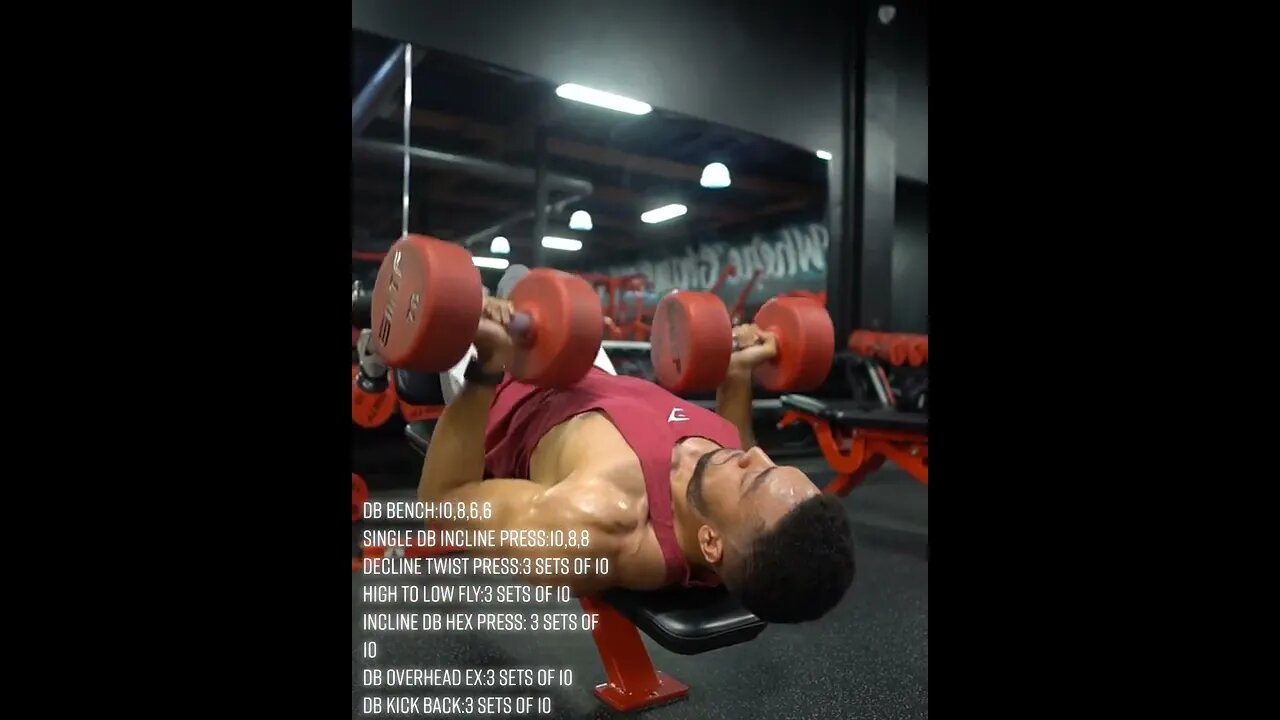Premium Only Content

SPOOKY CHEST & TRICEPS WORKOUT‼️#Shorts
➡️The Best Vertical Jump Program! Start now!!
https://bit.ly/VerticallJumpTraining
➡️BEST Products To IMPROVE Your Training Performance⤵️
https://bit.ly/JumpHigherr
➡️Best Supplements to Improve Your Workout
https://bit.ly/SupplementsForTraining
Vertical Jump Guide: How to Do Vertical Jumps Properly
Vertical jumps can become an essential part of your power-training program.
What Is a Vertical Jump?
The vertical jump, also known as the countermovement jump, is a plyometric training exercise that uses your bodyweight to activate muscle groups across your body. Perform vertical jumps by bending your hips, knees, and ankles until you lower to a quarter-squat position. Push into the ground and lift your body with an explosive movement. Use an arm swing movement to engage your upper body. While keeping your core engaged, land softly on the balls of your feet. Repeat this movement for the desired number of repetitions. Once you’ve practiced standard vertical jumps, consider trying other jumping variations like box jumps, depth jumps, drop jumps, and squat jumps.
Meet One of Your New Instructors
4 Benefits of Doing Vertical Jumps
Including vertical jumps in your strength-training program can have several benefits.
Vertical jumps increase leg strength and explosive power. By activating your glutes, hamstrings, quads, and calves, the vertical jump can increase your leg power and allow you to jump higher with practice.
Vertical jumps can improve your athletic performance. If you’re a volleyball or basketball player, vertical jump training can improve your sports performance and jumping ability.
Vertical jumps can improve your weightlifting form. Vertical jumping can improve your lower body explosiveness during weightlifting exercises like the power snatch.
Vertical jumps can improve your cardiovascular health. You can program your plyometric exercises into high-intensity interval training by performing several repetitions with set intervals, increasing your cardio fitness over time.
How to Measure a Vertical Jump Test
Although you can use a digital vertical jump tester, there is a simple way to measure your vertical jump height. Begin by standing next to a wall with a piece of tape on your fingertips. Place the tape on the wall to measure your standing reach height, which will act as your baseline. With another piece of tape on your fingertips, perform a vertical jump, placing the tape on the wall as high as you can. Use measuring tape to measure the distance between the two pieces of tape.
How to Do Vertical Jumps With Proper Form
For vertical jumps, begin by performing 2–4 sets of 1–5 repetitions. Choose your sets and repetitions based on your ability to maintain good technique throughout each set.
Stand with your feet shoulder-width apart and a slight bend in your knees. Your shoulders should be directly over your hips with a neutral head and neck position. Your arms should be long and by your sides. Your chin should remain tucked throughout the movement, as if you were holding an egg under your chin.
Evenly distribute your weight and grip the floor with your feet to create a stable position. Raise your arms above your head. Pre-tension your shoulders and hips with a good inhale and exhale. Engage your core. All repetitions should begin from this starting position.
Maintain a neutral spine as you quickly lower into a quarter-squat position by bending your hips and knees slightly. Maintain a fairly vertical shin position. Your arms should be long with a slight bend in your elbows. As you lower into your jumping position, allow your hands to travel behind your body. Your shin angle and torso angle should be relatively the same.
Begin your upward movement by explosively pushing your feet into the ground to jump into the air. As you begin to straighten your legs, simultaneously begin to swing your arms forward. Focus on being quick and powerful to jump as high as you can. At the top of your jump, your arms should be above your head with your upper arms in line with your ears. Your legs should be straight.
Land from your jump on the balls of your feet, evenly distributing the weight along your entire foot while allowing your hips and knees to bend to absorb force. Your landing posture should be the same as your jumping posture. Land softly and under control while keeping your core engaged throughout the landing. Your bodyweight should be loaded into your midfoot and heel, while keeping your toes engaged and your knees in line with your toes. Your chest should be ahead of your hips.
Stick the landing and then set up for another repetition. Back Workout #Shorts
AMAZING JUMP #shorts #exerciseroutine
Link do Video: https://youtu.be/fBAMTzRvBI8
4 exercises to help YOU jump higher (VOL. 3) #Shorts
-
 LIVE
LIVE
Dr Disrespect
3 hours ago🔴LIVE - DR DISRESPECT - THE FINALS - NEW SEASON 8 LAUNCH EVENT W/ THE SHOTTY BOYS
1,696 watching -
 11:49
11:49
Dr. Nick Zyrowski
9 days ago12 Unusual NAC ( N-Acetyl Cysteine) Questions Nobody Ever Answers
1.5K5 -
 1:03:45
1:03:45
Russell Brand
2 hours agoWW3 IMMINENT! Israel & Russia Strikes Leave World “ON THE BRINK” - SF631
91.8K45 -
 56:18
56:18
Tucker Carlson
1 hour agoSam Altman on God, Elon Musk and the Mysterious Death of His Former Employee
14.5K32 -
 1:12:40
1:12:40
Sean Unpaved
2 hours agoJalen Carter's 1-Game Suspension & The Pressure for Instant Greatness in Sports
16.8K1 -
 LIVE
LIVE
LindellTV
47 minutes agoBREAKING: MICHIGAN JUDGE THROWS OUT CRIMINAL CHARGES
177 watching -
 11:34
11:34
The Kevin Trudeau Show Limitless
4 hours agoClassified File 4 | The Hidden Science of Brain Control REVEALED!
3173 -
 LIVE
LIVE
Silver Dragons
1 hour agoDealer Reveals Best SILVER to Buy on a TIGHT Budget
83 watching -
 4:07
4:07
Michael Heaver
7 hours agoFrance Absolutely IMPLODING Under Macron
205 -
 LIVE
LIVE
The Boomer Effect
2 hours agoHealth Freedom & Silver Science: Disrupting the System
9 watching